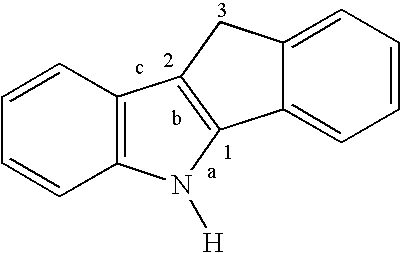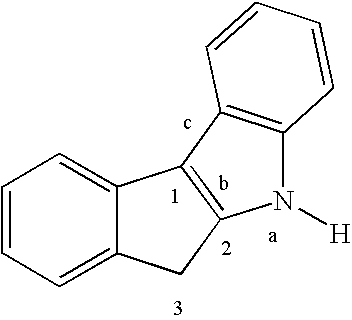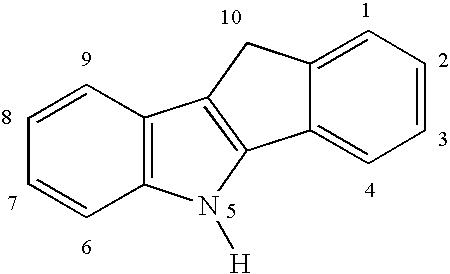Method for making polyolefins
- Summary
- Abstract
- Description
- Claims
- Application Information
AI Technical Summary
Benefits of technology
Problems solved by technology
Method used
Image
Examples
example 1
Preparation of a Dimethylsilyl-bridged Indeno[1,2-b]indolyl Cyclopentadienyl Zirconium Complex (6)
[0037](a) Preparation of Indeno[2-b]indole 1. A mixture of 1-indanone (30.6 g, 232 mmol) and p-tolylhydrazine hydrochloride (37.0 g, 233 mmol) in EtOH (350 mL) and aqueous HCl (12 N, 18 mL) are heated to reflux for 90 min. The mixture is cooled and filtered, and the solid is washed with EtOH (600 mL) followed by 20% aqueous EtOH (400 mL) and finally hexanes (200 mL). The off-white solid is dried under vacuum (36.5 g, 72%).
[0038](b) N-Methylation of 1. A mixture of 1 (36.5 g, 166 mmol), aqueous NaOH solution (112 mL, 20 M, 2.2 mol), C16H33NMe3Br (0.65 g, 1.78 mmol), and toluene (112 mL) is vigorously stirred at room temperature. A solution of Mel (17.0 mL, 273 mmol) in toluene (15 mL) is added dropwise, and the mixture is stirred at room temperature for 4 h and refluxed for 3 h. A crystalline solid forms upon cooling and is filtered and washed with cold (−78° C.) EtOH (300 mL) followed b...
example 2
Preparation of a Dimethylsilyl-bridged Indeno[1,2-b]indolyl Fluorenyl Zirconium Complex (10)
[0044](a) Preparation of 9-Chlorodimethylsilylfluorene (7). A slurry of fluorene (24.0 g, 144 mmol) in Et2O (400 mL) is cooled to 0° C., and n-BuLi (90.0 mL, 2.5 M in hexanes, 225 mmol) is added dropwise. The solution turns orange and warms to room temperature overnight. A solution of SiCl2Me2 (210 mL, 1.73 mol) in Et2O (100 mL) is cooled to 0° C., and the fluorenyl anion is added dropwise. A precipitate forms immediately, and the mixture is stirred for 24 h and filtered. Volatiles are removed under reduced pressure, and the residue is washed with hexanes (100 mL) and filtered. The white solid is collected and dried under vacuum. A second crop is isolated from the hexanes wash (combined yield: 28.7 g, 77%).
[0045](b) Reaction with 3 to give 8. A solution of 3 (15.3 g, 64.2 mmol) in toluene (250 mL) and Et2O (100 mL) is added dropwise to a solution of 7 (16.6 g, 64.0 mmol) in Et2O (100 mL). The...
example 3
Preparation of a Dimethylsilyl-bridged Indeno[2,1-b]indolyl Cyclopentadienyl Zirconium Complex (15)
[0048](a) Preparation of Indeno[2,1-b]indole 11. A mixture of 2-indanone (51.0 g, 0.39 mol) and p-tolylhydrazine hydrochloride (61.4 g, 0.39 mol) is dissolved in glacial acetic acid (525 mL) and is vigorously stirred and heated to reflux. The mixture turns red and is heated for 2 h. After cooling to room temperature, it is poured into ice water (1 L). The precipitate is filtered to afford a solid, which is washed with water (about 1 L). The solid is dissolved in ethyl acetate (1.4 L), activated charcoal is added, and the mixture is gently warmed. The mixture is then cooled and filtered over a pad of Celite. The filtrate is dried over Na2SO4, filtered, and is then concentrated to 450 mL and cooled to −30° C. for 3 days. The crystalline solid is filtered and washed with chilled (−78° C.) hexanes (2×500 mL). The beige solid is collected and dried under vacuum (47.1 g, 56%).
[0049](b) N-Met...
PUM
| Property | Measurement | Unit |
|---|---|---|
| Density | aaaaa | aaaaa |
| Density | aaaaa | aaaaa |
| Density | aaaaa | aaaaa |
Abstract
Description
Claims
Application Information
 Login to View More
Login to View More - R&D
- Intellectual Property
- Life Sciences
- Materials
- Tech Scout
- Unparalleled Data Quality
- Higher Quality Content
- 60% Fewer Hallucinations
Browse by: Latest US Patents, China's latest patents, Technical Efficacy Thesaurus, Application Domain, Technology Topic, Popular Technical Reports.
© 2025 PatSnap. All rights reserved.Legal|Privacy policy|Modern Slavery Act Transparency Statement|Sitemap|About US| Contact US: help@patsnap.com



